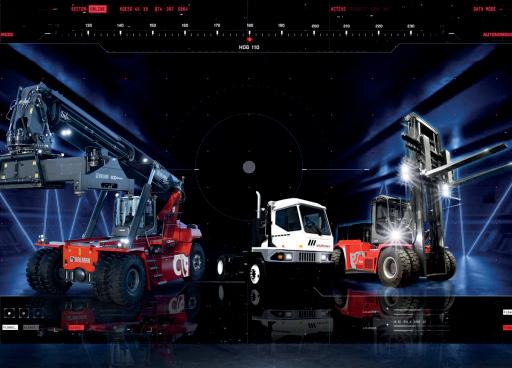
3 minute read
Kalmar goes electric
KALMAR GOES ALL ELECTRIC…
Kalmar is launching a new range of products for the port and logistics industry, with a specifi c focus on electric power and the application of robotic equipment.
The Cargotec-owned company has launched its new Kalmar Electric Reachstacker, Kalmar Electric Heavy Forklift and a Kalmar Ottawa Electric Terminal Tractor, which fulfils an objective of delivering a fully electric portfolio for the start of 2022.
The new electric reachstacker range consists of eight models, comprising six top lift items and two combi lift, with lifting capabilities of up to 45 tons. Importantly, all of the models in this range are fuelled by lithium-ion batteries with Bosch Rexroth drivelines.
The new electric forklift trucks feature seven lithium-ion powered models all with Bosch Rexroth drivelines. Lifting capacities range from 18 to 33 tons.
In addition, the Ottawa T2E+ Electric Terminal Tractor range includes five lithium-ion batterypowered models, with three models targeting work in logistics facilities and two designed for container terminal applications. Kalmar notes that this range aims to replace the Kalmar Ottawa T2E, which was launched in North America in 2018.
One advantage of the new electric range is a built-in thermal management system which allows the equipment’s batteries to remain within an optimal temperature range at all times, thereby enabling the machinery to work effectively across a wide range of varying climates.
Michael van Roozendaal, President, Kalmar Mobile Solutions elaborates: “In 2018 when we made our promise to have our full offering available as electrically powered by 2021, over 50 per cent of our cargo handling equipment was already available with electric power sources… we have a strong track record in bringing to market solutions that help our customers to reduce the environmental impact of their operations.”
8 Kalmar’s new electric reachstacker
is one of eight new models
...AND A FOCUS ON ROBOTICS

Kalmar has also introduced a new range of intelligent, fl exible and autonomous mobile equipment solutions that have been designed to improve safety and eco-effi ciencies but without negatively impacting operational productivity. This new equipment has been dubbed as the Kalmar Robotic Portfolio.
The new portfolio comprises the Kalmar RoboTractor, RoboLifter, RoboStacker and RoboHandler. The company has confirmed that prototypes of each item of equipment are currently being tested at various locations globally.
Kalmar explains that moving “intelligence” from central systems to the equipment means robotised solutions offer greater equipment flexibility and scalability. This makes the machinery particularly suitable to companies that are operating smaller equipment fleets.
In addition, all of the equipment in the Kalmar Robotic Portfolio will be built on a standardised platform, which means that it will also be a more simplistic and cost effective process to deploy with the help of cloud technologies – the company additionally confirms that the new equipment is fully compatible with all Kalmar automation solutions.
Lasse Eriksson, Vice President, Technology, Kalmar, sets out the company’s thought process behind the new equipment: “With this new portfolio we are laying the foundations for a future driven by fully autonomous, unmanned material handling with zero accidents, zero emissions and maximum productivity.”
8 Accessibility to automation
and robotics technologies for new customer segments, such as distribution centres, as well as the established ports and terminals market is being targeted
BRIEFS
Napoleon cranes
The Napoleon Avenue Container Terminal at the Port of New Orleans (Port NOLA) has taken delivery of four new Post Panamax cranes from ZPMC in China. The project represents an investment of US$112 million at the facility, including US$49 million for the construction and delivery of the new units and a further US$63 million to modernise the existing wharf and extend the crane rail infrastructure.
Visy in Egypt
October Dry port, Egypt, has awarded the tender for delivery of truck and rail Optical Character Recognition (OCR) portals alongside a gate operating system (GOS) to Finnish-based Visy and its partner, Prime Trading & Contracting. On-site installation work is scheduled to commence before the end of Q1 2022. The award is the second OCR project for Visy in Egypt – in 2017 it was awarded the delivery of truck OCR and automated gate solutions for the Alexandria Container Terminal.










